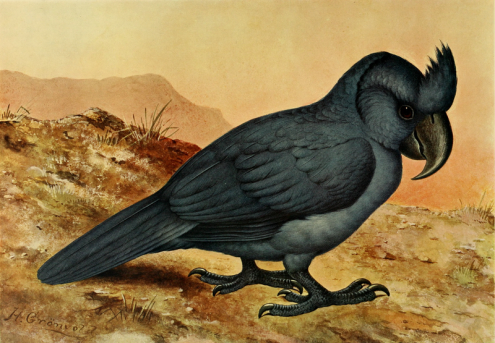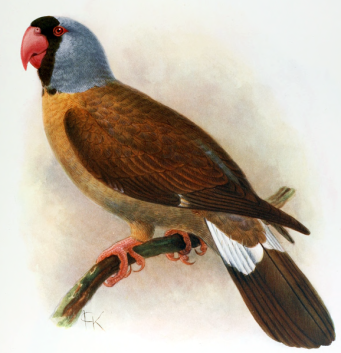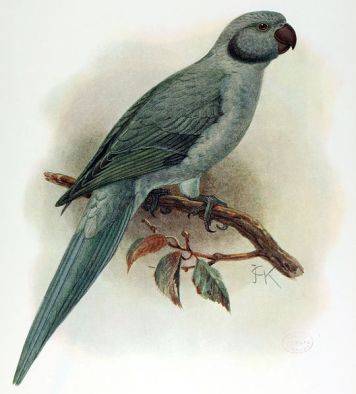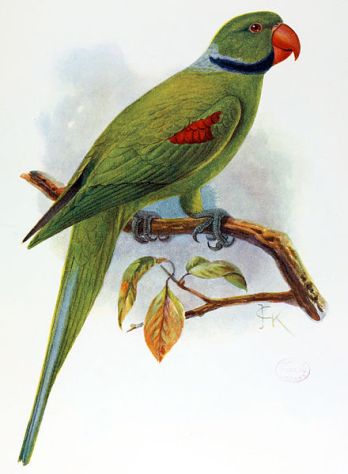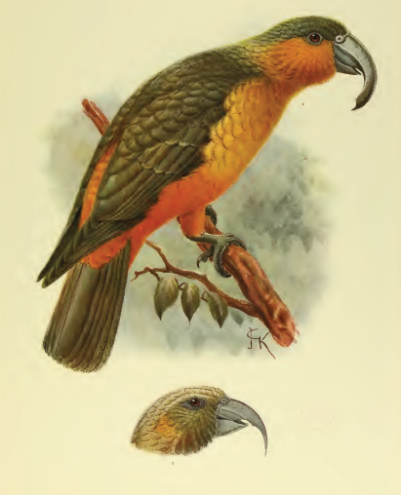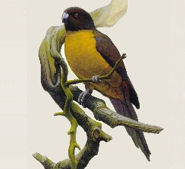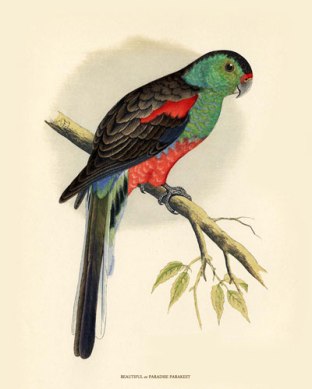Extinct Parrots of the Eastern Hemisphere
In my last post, I introduced the extinct parrots of the Western Hemisphere. In this post, I will introduce the extinct parrots of the Eastern Hemisphere. All but one of these extinct species occurred on small islands. Parrot species restricted to small islands are particularly prone to extinction for several reasons. First, since island species occur on very small areas, populations will naturally be small, so any amount of habitat destruction or hunting will have a negative effect on them. Additionally, isolated islands often lack mammals, which are not as effective as dispersing to islands as the more mobile birds are. As a result, species on isolated islands often lose their instinctive fear of mammals and thus suffer greatly when humans and their pets and livestock arrive.
Extinct Parrots of the Mascarene Islands
The Mascarene Islands are in the Indian Ocean east of Madagascar. They include Mauritius, Réunion and Rodrigues, along with several smaller islands. They are volcanic in origin, which means they were never attached to any mainland. This implies that all flora and fauna there would have had to disperse there from other islands or the continents. Thus, there are many birds on the islands, but few mammals. No humans inhabited the islands until Europeans arrived there in the 1600s, an event that was catastrophic for the birds.
Above: map showing location of the Mascarene Islands.
Much of the bird fauna of the Mascarene Islands is now extinct and this includes a few parrot species. The Broad-billed Parrot (Lophopsittacus mauritianus) was found on the island of Mauritius. It was a very curious-looking animal and what is known about its appearance is based on subfossils, three drawings, and two written descriptions. It was quite large, grey (possibly with a blue head), and had a small crest of feathers on the head. It was evidently a very slow, poor flier. Given the lack of ground-based mammalian predators on Mauritius, several species (such as the infamous dodo) evolved flightlessness or poor flight ability. Flight, and the development of the large muscles needed for flight, is a very energetically expensive process, so when bird species have no need for flight to escape predators or forage, they often lose their flying abilities. The Broad-billed Parrot appeared to eat large seeds that could be found on the ground, so it did not need flight to forage.
Due to its evolutionary history spent on an island with no mammalian predators, Broad-billed Parrots had very little natural fear of man or other mammals, and they were hunted extensively by European travellers and settlers. Introduced rats, cats, mongooses and monkeys also likely preyed on the birds’ eggs and young. The Broad-billed Parrot did not last long after the arrival of mammals to Mauritius, and they disappeared in the late 1600s.
Another parrot existed on the island of Mauritius. It has been placed in the genus Lophopsittacus, but was recently moved to Psittacula, which is the genus that contains the Indian Ring-neck Parakeet. This species, the Mauritius Grey Parrot, or Thirioux’s Grey Parrot, is known from archaeological specimens and traveller’s accounts. It was hunted to extinction because it was extremely easy to catch. Sketches made by Dutch travellers in the 1600s show hunters catching the birds by hand.
Mauritius Grey Parrots were also very attracted to the distress calls of their flockmates; thus, when one bird was caught, it would call and attract other birds. These other birds could then be easily caught by hunters. Grey parrots were also found on the island of Réunion, and they may have been a subspecies of the Mauritius Grey Parrots. They, too, were very easy to catch. They were extinct by the 1750s.
The Mascarene Parrot (Mascarinus mascarinus) occurred on the island of Réunion, and possibly Mauritius (based on vague traveller’s descriptions). It is known from subfossils, descriptions and specimens. Two specimens of this bird still exist in museums.
If Mascarene Parrots occurred on Mauritius, they likely went extinct there very shortly after the arrival of humans. A few specimens were brought to Europe, but most died by 1800, although one hung on until 1834. They were likely gone from the wild by 1800.
Small amounts of DNA have been extracted from a museum specimen of the Mascarene Parrot. Phylogenetic analyses have shown that this species is most closely related to the Lesser Vasa Parrot (Coracopsis nigra, also known as the Black Parrot). Lesser Vasa Parrots occur on Madagascar, Comoros, Mayotte and Seychelles.
The Rodrigues Parrot (Necropsittacus rodericanus) occurred on the island of Rodrigues. It is known from traveller’s descriptions and subfossils. They were green, with large heads and long tails. The last report of the species being seen alive was in 1761.
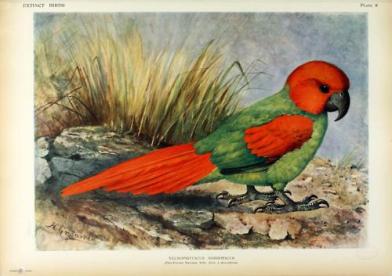
Rodrigues Parrot, illustration by J. G. Keulemans. As decriptions of this bird were rather vague, the accuracy of this reproduction is unknown.
Another now extinct parrot also occurred on Rodrigues – the Newton’s Parakeet (or Rodrigues Parakeet). This bird was smaller than the Rodrigues Parrot and was about the size of an Indian Ringneck. Unlike wild Indian Ringneck Parakeets, these birds were a slate-grey colour. They looked much like the grey variants of the Indian Ringneck which occurs in some avicultural collections. There are two skins of this bird in existence, and both are at the Cambridge University Museum. The Newton’s Parakeet was last seen alive in 1875.
The Seychelles
The Seychelles are an island chain located in the Indian Ocean, north of the Mascarene Islands and east of Kenya and Tanzania. Like the Mascarene Islands, the Seychelles lost much of its fauna shortly after the arrival of humans. However, the losses weren’t quite as severe as they were on the Mascarene Islands. However, one parrot species was lost from the island chain: the Seychelles Parakeet (Psittacula wardi).
Ten specimens of the Seychelle’s Parakeet exist today. The bird resembled the Alexandrine Parakeet, but lacked the rosy-coloured collar on the nape and instead had some blue suffusion there and on the cheeks.
The Seychelle’s Parakeet disappeared during the early 1900s. It was apparently a crop pest and was hunted extensively by farmers.
Norfolk Island
Norfolk Island is located between New Zealand and New Caledonia. It was inhabited by Polynesians for several generations during the fourteenth-fifteenth centuries, although it was uninhabited when James Cook visited it in 1774. The bird fauna of this island suffered greatly as humans started settling it, and several species were driven to extinction due to predation by rats and cats. Some bird species were also persecuted by humans for being agricultural pests. One of the extinct species was a parrot, the Norfolk Island Kaka (Nestor productus).
The Norfolk Island Kaka was closely related to the Kaka (Nestor meridionalis) of New Zealand. They resembled New Zealand Kaka but had more orange colouring on the breast and cheeks. Several specimens of this species still exist in zoological museums. The Norfolk Island Kaka appears to have disappeared from the wild by the 1830s, and the last captive one died in 1851.
French Polynesia
There are two extinct parrot species that occurred in French Polynesia, and both are closely related to the Kakarikis of New Zealand.
The Society Parakeet (Cyanoramphus ulietanus) occurred on the island of Raiatea in the Society Islands and it went extinct shortly after its discovery in the late 1700s. Two museum species of this species exist. Unlike the New Zealand Kakarikis, this bird had largely earth-toned feathers. Predation by invasive species (such as rats) likely contributed to its demise.
The Black-fronted Parakeet (or Tahiti Parakeet, Cyanoramphus zealandicus) was endemic to Tahiti, and it lasted somewhat longer than the Society Parakeet, as it went extinct in the 1800s. Black-fronted Parakeets looked much like the New Zealand Kakarikis, but they had black lores, red cheeks and red rumps. There are a few specimens of this bird in zoological museums. As is the case with many other species from isolated islands, predation by introduced mammals contributed greatly to demise of the Black-fronted Parakeet.
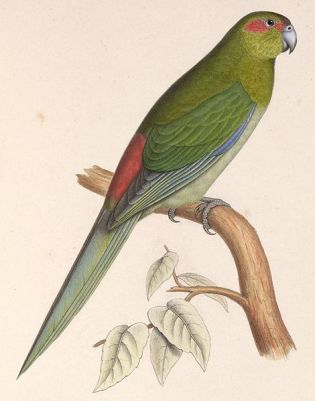
Black-fronted Parakeet, illustration from Iconographie Orthinologique, by Marc Athanase Parfait Œillet Des Murs.
Australia
The last bird discussed here is the only one that did not occur on a small island. The Paradise Parrot (Psephotus pulcherrimus) occurred in northeastern Australia and the last confirmed observation of it was in 1928, although some claimed to see it later than that. Factors that lead to its extinction include habitat destruction, drought, overgrazing, and predation of nests by introduced and native predators.
As its name suggests, the Paradise Parrot was a very colourful and beautiful bird. It was a vivid green-blue, with scarlet feathers on the rump, abdomen, chest and head, and black feathers on the top of the head, wings and back. A few black and white photos of the bird exist, along with museum specimens. They were largely ground feeders and were quite approachable.
The Paradise Parrot is a close relative of the Red-rumped Parrot (Psephotus haematonotus), the Mulga Parrot (Psephotus varius), the Blue Bonnet (Psephotus haematogaster) and Golden-shouldered Parrot (Psephotus chrysopterygius).
References
Forshaw, J. M., and Cooper, W. T. (Illustrator). 1977. Parrots of the World. TFH Publications, Neptune, NJ, USA.
Hume, J. P. 2007. Reappraisal of the parrots (Aves: Psittacidae) from the Mascarene Islands, with comments on their ecology, morphology, and affinities. Zootaxa, 1513, 1-76.
IUCN 2012. IUCN Red List of Threatened Species. Version 2012.1. www.iucnredlist.org
Kundu, S. Jones, C. G., Prys-Jones, R. P., and Groombridge, J. J. 2012. The evolution of the Indian Ocean Parrots (Psittaciformes): Extinction, adaptive radiation, and eustacy. Molecular Phylogenetics and Evolution, 62, 296-305.

